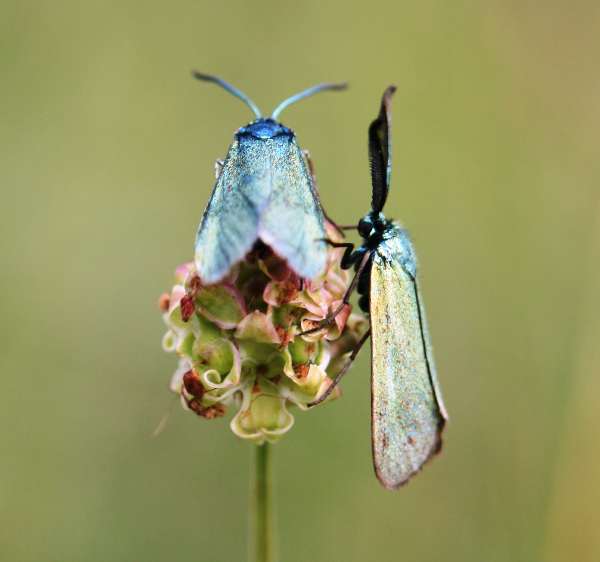Forester Moth - Adscita statices
Phylum: Arthropoda - Class: Insecta - Order: Lepidoptera - Family: Zygaenidae

Like most members of the Burnet group, this is one of the day-flying moths, but its metallic yellow-green coloration makes it very easy to separate from other common members of the group. (There are 800 to 1000 members of the family Zygaenidae worldwide, but the vast majority are confined to the tropics. Some forty or so occur in northern temperate zone in Europe and North America.)
Foresters belong to the genera Theresimima, Rhagades, Jordanita and Adscita within the sub-family Procridinae.
Distribution
This is the most common and widespread of the three Forester species seen in Britain, and with a wingspan of 2.5 to 2.8cm it is also the largest. (The slightly smaller Cistus Forester, Adscita geryon, occurs in limestone districts where its larval foodplant, Common Rock-rose, Helianthemum nummularium, is plentiful. The Scarce Forester, Jordanita globulariae, also occurs in Britain. Confined to central-southern and south-east England, this moth is now very rare; its larval foodplants are Common Knapweed, Centaurea nigra, and Greater Knapweed, Centaurea scabiosa.)
Lifecycle
The primary larval foodplant of the Forester Moth is Common Sorrel, Rumex acetosa. Eggs are laid on a leaf, and the young larvae cut their way through the leaf and then feed on leaves lower down on the plant. They pupate in cocoons among vegetation near to the ground.
The caterpillar is pale yellow-green and has a dark dorsal stripe; it also has fine white hairs on its back.
In the UK, adult Forester Moths can be seen flying from mid May to early August.
Studying butterflies and moths...
Excited at the prospect of flyfishing? So are we, and we're pretty sure you would find the Winding River Mystery trilogy of action-packed thrillers gripping reading too. Dead Drift, Dead Cert, and Dead End are Pat O'Reilly's latest river-and-flyfishing based novels, and now they are available in ebook format. Full details on our website here...
Buy each book for just £4.96 on Amazon...
Please Help Us: If you have found this information interesting and useful, please consider helping to keep First Nature online by making a small donation towards the web hosting and internet costs.
Any donations over and above the essential running costs will help support the conservation work of Plantlife, the Rivers Trust and charitable botanic gardens - as do author royalties and publisher proceeds from books by Pat and Sue.
